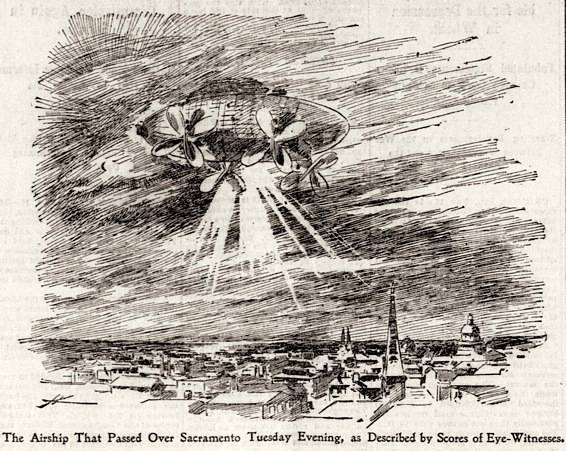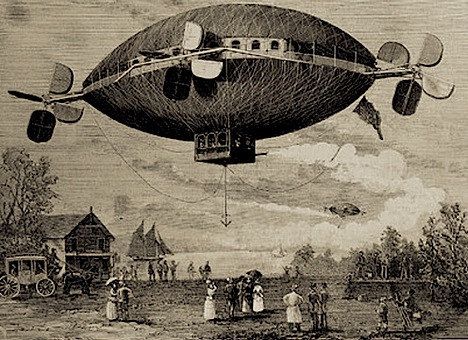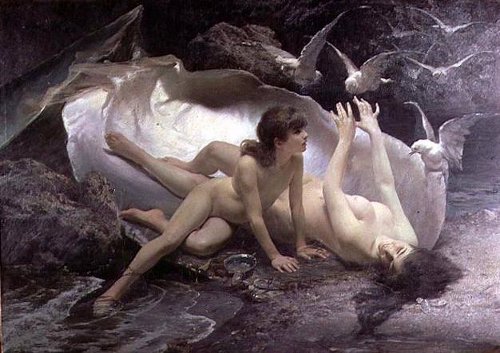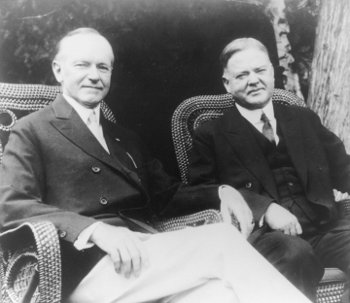Letter to the Times, Feb. 6, 1946:
Sir,
I have just written you a long letter.
On reading it over, I have thrown it into the waste paper basket.
Hoping this will meet with your approval,
I am, Sir,
Your obedient Servant,
A.D. Wintle
Letter to the Times, Feb. 6, 1946:
Sir,
I have just written you a long letter.
On reading it over, I have thrown it into the waste paper basket.
Hoping this will meet with your approval,
I am, Sir,
Your obedient Servant,
A.D. Wintle

November 1896 saw the start of a strange wave of airship sightings across the United States — the San Francisco Call published the image above on Nov. 19, claiming that the craft had passed over eastern Sacramento the previous night, where hundreds had seen “its brilliant searchlight traveling over the city, and who will also swear that they heard the voices of its occupants and distinguished their merry song and laughter.”
In the frenzy that followed, the San Francisco Chronicle published an interview with attorney George D. Collins, who claimed that he represented the airship’s inventor, a wealthy Maine man who had spent 17 years and $100,000 perfecting the craft. “The reports from Sacramento the other night were quite true. It was my client’s ship that inhabitants saw. It started from Oroville, in Butte County, and flew in a straight line for sixty miles directly over Sacramento. After running up and down once or twice over the capital, my friend came on a distance of another seventy miles and landed on a spot on the Oakland side of the bay, where the ship now lies guarded by six men. In another six days several defects will be done away with and it is then his intention to fly right over San Francisco.”
That never happened, and Collins was quickly forgotten, but it’s interesting to note that 10 years earlier, in 1886, inventor Moses Cole had patented a strikingly similar “new and improved aerial vessel” (below). “It consists of two semi-spheroidal balloons,” Scientific American had reported, “between which are situated the cabins for the passengers and crew, these being fitted with windows and surrounded by a circular balcony.” Possibly the Call’s artist had used Cole’s patent for inspiration. Or possibly Collins was telling the truth. Or possibly Martians had adopted Cole’s design as a disguise. We’ll never know.

See Just Visiting.
Imagine a 1000 x 1000 chessboard on which a white king and 499 black rooks are placed at random such that no rook threatens the king. And suppose the king goes bonkers and wants to kill himself. Can he reach a threatened square in a finite number of moves if Black is trying actively to avoid this?

The last canto of Dante’s Purgatorio contains this perplexing sentence:
And if perchance
My saying, dark as Themis or as Sphinx,
Fail to persuade thee, (since like them it foils
The intellect with blindness) yet ere long
Events shall be the Naiads, that will solve
This knotty riddle, and no damage light
On flock or field.
When did water nymphs solve the riddle of the Sphinx? It turns out that Dante was relying on a flawed medieval edition of Ovid’s Metamorphoses that rendered Laïades (meaning Oedipus, the son of Laius) as Naïades, or naiads. He believed that water nymphs had ridden their sea monsters across the desert to solve the Sphinx’s riddle.
The version of the story that we know, in which Oedipus solves the riddle, comes from Sophocles’ Oedipus, which, being written in Greek, was unavailable to Dante. And he cast his own version in such exquisite language that it’s now immortal — one classic work misquoting another.
(Thanks, Jim.)
The sum of the squares of the reciprocals of the positive integers is π2/6.
The sum of their fourth powers is π4/90.
The sum of their sixth powers is π6/945.
The area of the region under the Gaussian curve y = e–x2 is the square root of π.
The probability that two integers chosen at random will have no prime factor in common is 6/π2.
The integer 8 can be written as the sum of two squares of integers, m2 + n2, in four ways, when (m, n) is (2, 2), (2, -2), (-2, 2), or (-2, -2). The integer 7 can’t be written at all as the sum of such squares. Over a very large collection of integers from 1 to n, the average number of ways an integer can be written as the sum of two squares approaches π. Why?

“Mr. Hoover, if you see ten troubles coming down the road, you can be sure that nine will run into the ditch before they reach you and you have to battle with only one of them.” — Calvin Coolidge, to Herbert Hoover
As skywatchers prepared for the return of Halley’s comet in 1910, they heard some alarming scientific predictions: Poisonous gases in the comet’s tail might “snuff out all life on the planet,” “leaving the burnt and drenched Earth no other atmosphere than the nitrogen now present in the air.” How should a responsible citizen evaluate a dire prediction by a minority of experts? In this week’s episode of the Futility Closet podcast, we explore the Halley’s hysteria, remember the alarming predictions made for Y2K, and recall a forgotten novella in which Arthur Conan Doyle imagined a dead Earth fumigated by cosmic ether.
We also consider the odd legacy of an Australian prime minister who disappeared in 1967, investigate the role of balloon-borne sheepdogs during the Siege of Paris, learn why Mark Twain’s brother telegraphed the entire Nevada constitution to Washington D.C. in 1864, and offer a chance to win a book in the next Futility Closet Challenge.

bibliotaph
n. a hoarder of books
In the rare book collection of the archives at Caltech is a copy of Adrien-Marie Legendre’s 1808 text on number theory. It comes from the collection of Eric Temple Bell, who taught mathematics at Caltech from 1926 to 1953. Inside the book is an inscription in Bell’s handwriting:
This book survived the San Francisco Earthquake and Fire of 18 April, 1906. It was buried with about 600 others, in a vacant lot, before the fire reached the spot. The house next door to the lot fell upon the cache; the tar from the roof baked the 4 feet of dirt, covering the books, to brick, and incinerated all but 4 books, of which this is one. Signed: E. T. Bell. Book buried just below Grace Church, at California and Stockton Streets. House number 729 California Street.
During the Great Fire of London in 1666, Samuel Pepys came upon Sir William Batten burying his wine in a pit in his garden. Pepys “took the opportunity of laying all the papers of my office that I could not otherwise dispose of” and later buried “my Parmazan cheese, as well as my wine and some other things.” I don’t know whether he ever recovered them.
James Watt perfects the steam engine, 1765:
I had gone to take a walk on a fine Sunday afternoon. I had entered the Green and had passed the old washing house. I was thinking up on the engine at the time and had got as far as the herd’s house, when the idea came into my mind that as steam was an elastic body it would rush into a vacuum, and that if a communication were made between the cylinder and an exhausted vessel it would rush into it and might there be condensed without cooling the cylinder. I had not walked farther than the golf house when the whole thing was arranged clearly in my mind.
Charles Darwin realizes why species diverge, 1840s:
I can remember the very spot in the road, whilst in my carriage, when to my joy the solution occurred to me; and this was long after I had come to Down. The solution, as I believe, is that the modified offspring of all dominant and increasing forms tend to become adapted to many and highly diversified places in the economy of nature.
Henri Poincaré discovers the relation between automorphic functions and non-Euclidean geometries, 1881:
Just at this time, I left Caen, where I was living, to go on a geologic excursion under the auspices of the School of Mines. The incidents of the travel made me forget my mathematical work. Having reached Coutances, we entered an omnibus to go some place or other. At the moment when I put my foot on the step, the idea came to me, without anything in my former thoughts seeming to have paved the way for it, that the transformations I had used to define the Fuchsian functions were identical with those of non-Euclidian geometry. I did not verify the idea; I should not have had time, as, upon taking my seat in the omnibus, I went on with a conversation already commenced, but I felt a perfect certainty. On my return to Caen, for conscience’ sake, I verified the result at my leisure.
Walter Cannon recognizes the fight-or-flight response, 1911:
As a matter of routine I have long trusted unconscious processes to serve me. … [One] example I may cite was the interpretation of the significance of bodily changes which occur in great emotional excitement, such as fear and rage. These changes — the more rapid pulse, the deeper breathing, the increase in sugar in the blood, the secretion from the adrenal glands — were very diverse and seemed unrelated. Then, one wakeful night, after a considerable collection of these changes had been disclosed, the idea flashed through my mind that they could be nicely integrated if conceived as bodily preparations for supreme effort in flight or in fighting.
William Rowan Hamilton conceives the fundamental formula for quaternions, 1843:
But on the 16th day of the same month — which happened to be a Monday, and a Council day of the Royal Irish Academy — I was walking in to attend and preside, and your mother was walking with me, along the Royal Canal, to which she had perhaps driven; and although she talked with me now and then, yet an under-current of thought was going on in my mind, which gave at last a result, whereof it is not too much to say that I felt at once the importance. An electric circuit seemed to close; and a spark flashed forth, the herald (as I foresaw, immediately) of many long years to come of definitely directed thought and work, by myself if spared, and at all events on the part of others, if I should even be allowed to live long enough distinctly to communicate the discovery.
Hamilton adds: “Nor could I resist the impulse — unphilosophical as it may have been — to cut with a knife on a stone of Brougham Bridge, as we passed it, the fundamental formula with the symbols, i, j, k; namely,
i2 = j2 = k2 = ijk = -1
which contains the Solution of the Problem, but of course, as an inscription, has long since mouldered away.” The bridge now bears a permanent plaque marking Hamilton’s achievement (below), and mathematicians undertake an annual walk from Dunsink Observatory to commemorate it.

Excerpts from “Body Ritual Among the Nacirema,” a paper published by Horace Miner in the June 1956 edition of American Anthropologist:
It’s a satire. What’s Nacirema spelled backward?